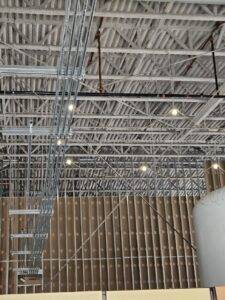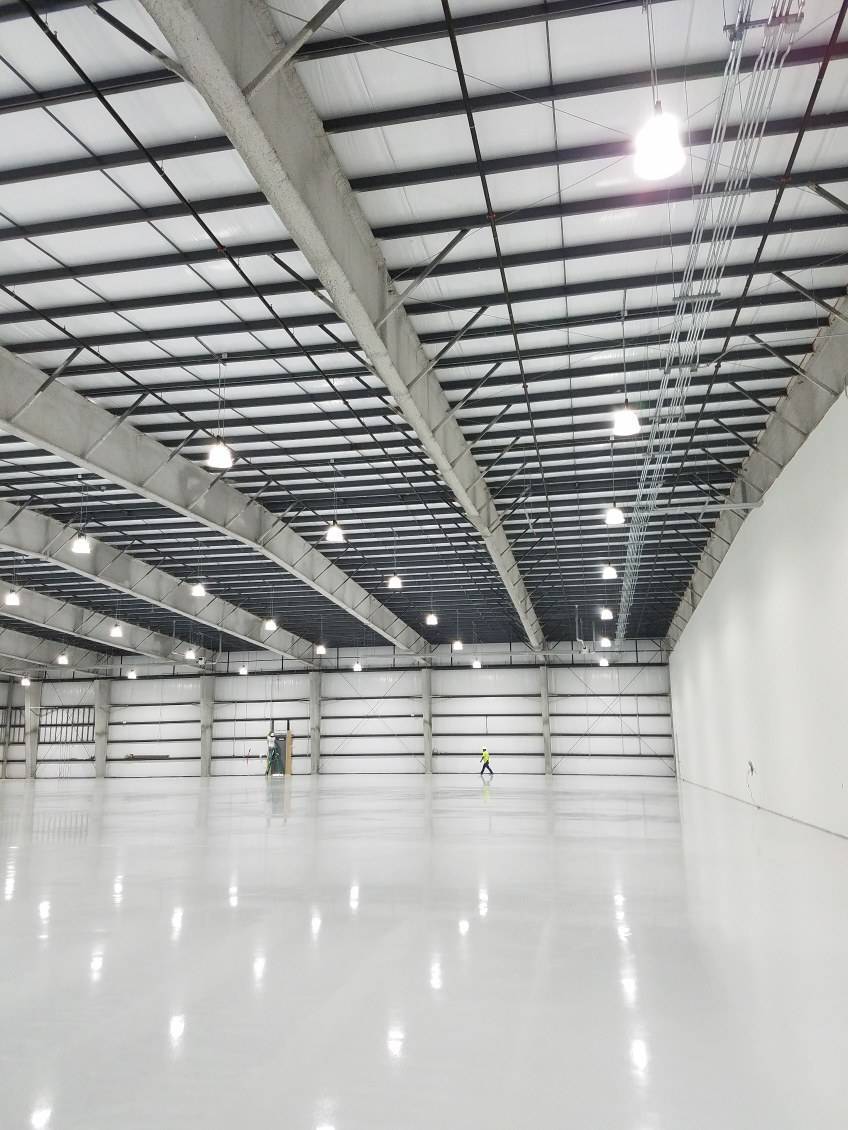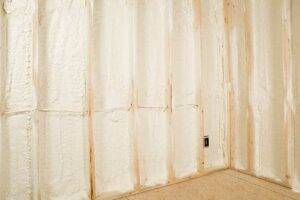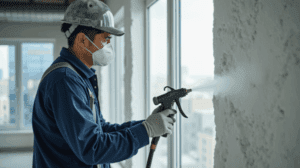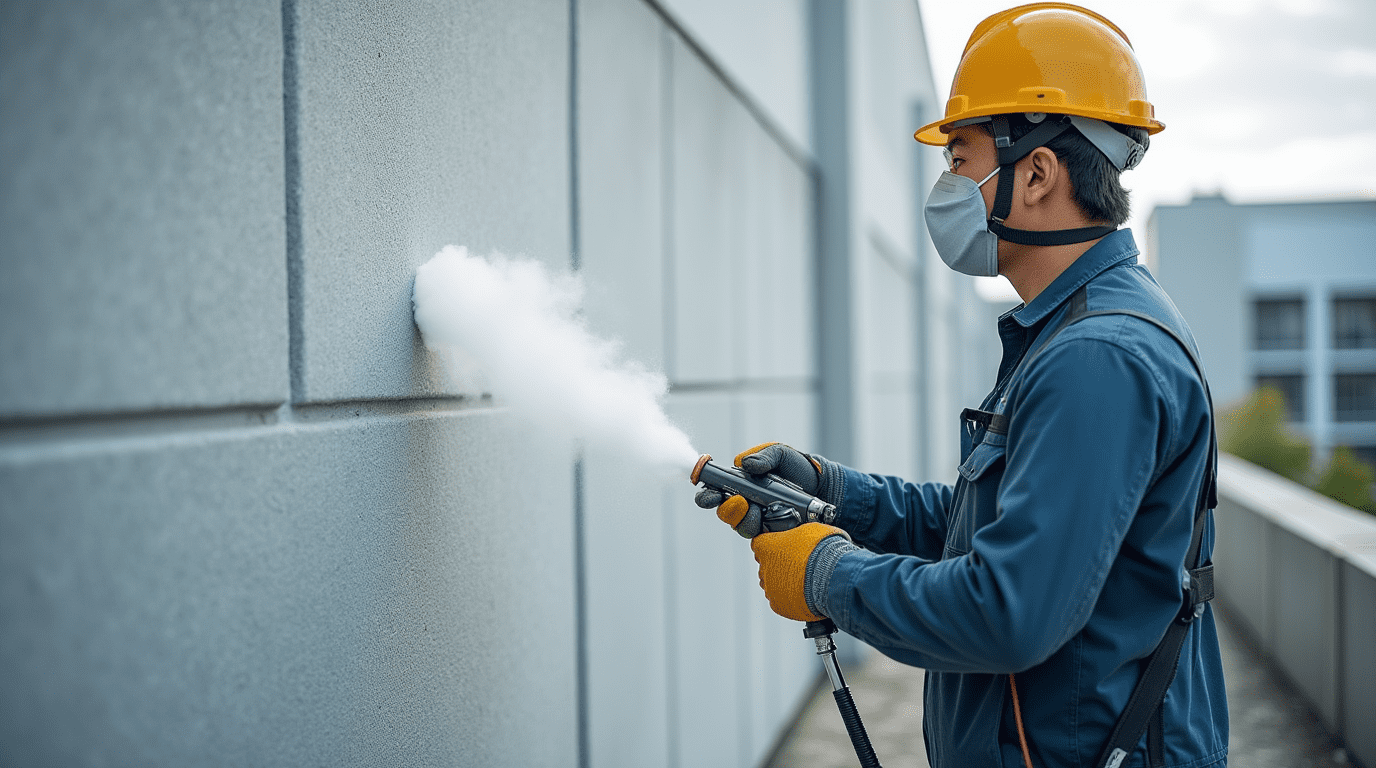K-13 Insulation Soundproofing: Why You Need It for Your Space
Bahl Fireproofing
Disruptive noise levels drain productivity and comfort in commercial facilities while acoustic panel systems create maintenance headaches and installation delays. K-13 spray-applied cellulose insulation solves both problems by delivering seamless sound absorption and thermal performance in a single application. This guide explains how K-13’s open-cell fiber structure controls reverberation, quantifies its Noise Reduction Coefficient performance across different thicknesses, compares acoustic and thermal benefits against panel alternatives, and demonstrates why Bahl Fireproofing’s certified installation process ensures code-compliant results across Texas, Kansas, and Oklahoma.
TLDR: K-13 spray insulation achieves NRC values up to 1.05 (depending on thickness and substrate) while delivering R-3.7 per inch thermal resistance through continuous open-cell cellulose coverage. Commercial spaces typically experience 15-25 percent improvements in speech intelligibility (typical for comprehensive acoustic treatments in reverberant spaces) combined with Class A fire resistance and 80 percent pre-consumer recycled content that supports LEED certification and sustainable building objectives.
Why Acoustic Control Matters in Commercial Buildings
We’ve seen too many open-plan offices where conversations at one desk disrupt entire work areas. Conference rooms where every word echoes off hard surfaces. Gymnasiums where announcements get lost in reverberation.
Poor acoustics aren’t just annoying. They reduce productivity, increase stress, and undermine the function of commercial spaces. Research consistently demonstrates that excessive noise in offices significantly decreases concentration and cognitive performance. In educational settings, poor speech intelligibility directly impacts learning outcomes.
Traditional acoustic panel systems try to solve these problems but create their own issues. Panels require attachment points, leave gaps at edges, and accumulate dust that degrades performance. They’re also separate from the thermal envelope, forcing projects to coordinate multiple trades and materials for what should be an integrated solution.
K-13 spray-applied cellulose insulation addresses both acoustic and thermal needs in one seamless application, reducing coordination complexity and delivering superior coverage compared to panel-based approaches.
What Is K-13 Insulation and How Does It Control Sound?
K-13 spray-applied insulation is a cellulose-based coating manufactured by International Cellulose Corporation. The material consists of 80 percent pre-consumer recycled paper fibers treated with fire-retardant additives and applied through specialized spray equipment that bonds the fibers directly to structural surfaces.
The installation creates a monolithic insulation layer without joints or seams. As technicians spray the cellulose mixture onto roof decks, open ceilings, or wall assemblies, the fibers interlock and adhere to form continuous coverage that conforms to complex geometries, around pipes, over beams, and across irregular surfaces.
How K-13’s Open-Cell Structure Absorbs Sound
K-13 absorbs sound through its open-cell fiber structure. When sound waves enter the material, they encounter countless fiber surfaces and air pockets. Each fiber intersection creates friction that converts acoustic energy into negligible heat, preventing sound from reflecting back into the space.
This mechanism proves especially effective for mid-range and high-frequency sounds (speech, footsteps, equipment noise). The open-cell structure allows sound waves to penetrate deep into the material rather than reflecting off a hard surface. Thicker applications also absorb lower frequencies, providing comprehensive acoustic control across the audible spectrum.
The cellulose fibers remain flexible rather than rigid, which helps dissipate sound energy more effectively than hard materials. This flexibility combined with the irregular fiber orientation creates multiple pathways for sound absorption throughout the material thickness.
K-13’s Noise Reduction Coefficient Performance
The Noise Reduction Coefficient quantifies how much sound a material absorbs across standard frequencies. K-13 delivers exceptional NRC performance that varies with application thickness and substrate configuration:
| Thickness | Substrate | NRC Value | Typical Application |
|---|---|---|---|
| 1.5 inches | Ribbed metal deck | 1.05 | Gymnasiums, auditoriums |
| 2.0 inches | Solid backing | 1.00 | Conference rooms, offices |
| 1.5 inches | Solid backing | 0.90 | Classrooms, retail |
These NRC values demonstrate K-13’s superior acoustic absorption compared to many traditional panel systems, which typically achieve NRC 0.70 to 0.85. The ability to reach NRC 1.00 or higher means K-13 provides highly effective sound absorption that significantly reduces reverberation and echo in occupied spaces.
It’s important to understand that NRC values above 1.00 don’t mean the material absorbs “all” sound. Instead, NRC above 1.00 indicates absorption exceeds flat surface predictions due to edge effects, air gaps between fibers, and the three-dimensional nature of the material. Some sound still reflects, but K-13’s performance significantly improves acoustic conditions in commercial environments.
Key Soundproofing Benefits for Commercial Buildings
K-13 insulation provides measurable acoustic improvements by reducing reverberation time, improving speech intelligibility, and controlling ambient noise levels in diverse commercial environments. These benefits translate into enhanced occupant comfort, better communication, and spaces that function as designed.
Reducing Reverberation and Improving Speech Clarity
Reverberation occurs when sound reflects repeatedly off hard surfaces, creating a prolonged decay that blurs speech and makes spaces feel loud even at moderate volume levels. K-13 shortens reverberation time by absorbing sound on first contact rather than allowing multiple reflections.
In boardrooms and lecture halls, comprehensive acoustic treatments with materials like K-13 typically improve speech intelligibility by 15 to 25 percent. This means conversations become clearer, presentations require less vocal strain, and occupants experience less fatigue from straining to understand speech.
Enhanced speech articulation supports compliance with accessibility standards that require specific intelligibility metrics in public spaces. Better acoustics also improve the function of audio systems, allowing lower amplification levels and reducing feedback problems.
Commercial Spaces That Benefit Most from K-13
Different building types face unique acoustic challenges where K-13’s seamless coverage and high NRC values provide distinct advantages:
Open-Plan Offices:
- Reduces ambient noise from conversations and equipment
- Improves privacy between workstations
- Decreases stress and distraction for focused work
- Supports productivity in collaborative environments
- Helps facilities address workplace noise exposure concerns that affect employee health
Educational Facilities:
- Enhances speech clarity in classrooms and lecture halls
- Reduces hallway noise transmission
- Improves learning outcomes through better communication
- Meets acoustical requirements for standardized testing environments
Gymnasiums and Auditoriums:
- Controls reverberation during assemblies and events
- Improves public address system intelligibility
- Reduces echo that creates uncomfortable sound environments
- Provides consistent acoustic performance across large volumes
Healthcare and Wellness Facilities:
- Supports acoustic privacy for patient consultations
- Reduces stress from excessive noise levels
- Meets LEED Indoor Environmental Quality requirements
- Creates healing environments through sound control
Comparing K-13 to Alternative Soundproofing Materials
Understanding how K-13 performs relative to other acoustic products helps facility owners and architects make informed material selections:
K-13 vs. Acoustic Ceiling Panels:
Acoustic ceiling panels (fiberglass tiles or fabric-wrapped boards) offer basic sound absorption but require suspension systems, leave gaps at edges, and accumulate dust that degrades performance. Panels typically achieve NRC 0.70 to 0.85 depending on thickness and mounting method.
K-13’s spray application eliminates gaps and provides superior coverage around penetrations, light fixtures, and irregular geometries. The seamless coverage prevents flanking paths where sound can bypass panel systems through gaps. K-13 also integrates thermal insulation (R-3.7 per inch), eliminating the need for separate envelope treatments.
K-13 vs. Spray Foam Insulation:
Closed-cell and open-cell spray foams provide thermal performance but significantly lower acoustic absorption. Most spray foams provide significantly lower acoustic performance than K-13. The chemical composition of foam also introduces off-gassing concerns and requires careful application to prevent over-expansion.
K-13’s cellulose composition avoids chemical off-gassing, provides superior sound absorption, and offers comparable thermal resistance (R-3.7 per inch) to open-cell foams. The water-based application system also creates safer installation conditions and better indoor air quality.
K-13 vs. Fiberglass Batt Insulation:
Fiberglass batts provide thermal resistance but minimal acoustic benefit in exposed applications. Batts also require cutting, fitting, and leave gaps around structural members that create both thermal bridges and acoustic flanking paths. Installation in irregular spaces proves difficult and time-consuming.
K-13 adapts to any geometry through spray application, fills penetrations automatically, and delivers integrated thermal-acoustic performance. The recycled cellulose content also supports sustainability objectives that fiberglass products cannot match.
Thermal and Acoustic Performance Working Together
K-13 insulation delivers both thermal resistance and acoustic absorption in a single application, streamlining project schedules and eliminating coordination between separate thermal and acoustic systems. This integrated performance reduces material interfaces, simplifies installation, and ensures consistent coverage.
K-13’s Thermal Performance and Energy Benefits
K-13 provides thermal resistance measured at R-3.7 per inch under ASTM C518 testing standards. This thermal performance slows heat transfer through building envelopes, maintaining stable interior temperatures and reducing HVAC loads.
| Attribute | Specification | Benefit |
|---|---|---|
| R-Value | 3.7 per inch | Reduces heat transfer through roof and wall assemblies |
| Air Infiltration Control | Continuous seamless coating | Eliminates drafts and convective heat loss |
| Moisture Management | Vapor-permeable structure | Prevents condensation without trapping moisture |
For typical commercial applications, K-13 installed at 2 to 3 inches provides R-7.4 to R-11.1, meeting or exceeding code requirements for exposed roof deck insulation in climate zones throughout Texas, Kansas, and Oklahoma.
The open-cell structure allows vapor permeability, meaning moisture can move through the assembly without creating trapped condensation that degrades thermal performance or promotes mold growth. This vapor management proves especially important in climates with significant temperature differentials between interior and exterior conditions.
Energy Savings from Integrated Thermal-Acoustic Systems
Commercial buildings that upgrade to K-13 insulation for combined thermal-acoustic performance can achieve measurable operating cost reductions. Based on industry data for comprehensive building envelope improvements, facilities with previously minimal insulation typically see energy consumption decreases of 15 to 20 percent after installing adequate thermal resistance.
These savings accumulate through:
- Reduced heating fuel consumption during winter months
- Lower electrical demand for cooling equipment during summer peaks
- Decreased HVAC runtime from improved envelope performance
- More stable interior temperatures requiring less thermostat adjustment
The integrated thermal-acoustic approach also reduces installation time compared to coordinating separate systems. Single-trade application eliminates scheduling conflicts and ensures thermal and acoustic coverage align perfectly without gaps or missed areas.
Fire Safety and Code Compliance
K-13 insulation provides Class A fire-resistant properties for exposed ceiling and wall applications, making it suitable for commercial spaces where insulation remains visible below structure. The cellulose fibers are factory-treated with fire-retardant additives that achieve flame spread of 5 and smoke development of 5 under ASTM E84 testing, far exceeding the Class A maximum thresholds of 25 and 50.
This Class A rating supports code compliance for interior finish requirements in commercial construction under the International Building Code. The superior fire performance (flame spread 5 vs. the 25 maximum) provides additional safety margin beyond minimum requirements.
It’s important to understand K-13’s role in fire protection: this material provides excellent Class A surface fire resistance for exposed decking and walls, but it is not a replacement for structural steel fireproofing where ASTM E119 fire-resistance ratings are required. For projects requiring both thermal insulation and structural protection, K-13 can be applied over spray-applied fire-resistive materials in UL-listed assemblies.
Sustainability and Indoor Environmental Quality
K-13 spray-applied insulation supports commercial sustainability objectives through recycled content, low emissions, and integrated performance that reduces overall material consumption.
Recycled Content and Resource Conservation
K-13 consists of 80 percent pre-consumer recycled paper fibers, diverting substantial waste from landfills and reducing demand for virgin materials. This high recycled content contributes to LEED v4 Material and Resources credits and supports corporate environmental responsibility commitments.
The manufacturing process uses significantly less energy than mineral-based insulation products, reducing embodied carbon in the building assembly. By specifying K-13, project teams advance waste reduction goals while achieving required thermal and acoustic performance.
Indoor Air Quality Benefits
K-13’s water-based, fiber-only formulation contains no volatile organic compounds, formaldehyde, or chemical off-gassing agents. Once cured, the material remains inert, minimizing airborne particulates that can affect respiratory health.
The product holds GREENGUARD Gold certification from UL, verifying low chemical emissions that support healthier indoor environments. This certification contributes to LEED Indoor Environmental Quality credits and aligns with wellness standards in schools, healthcare facilities, and corporate offices.
The cellulose composition also provides natural moisture buffering, helping stabilize relative humidity levels within occupied spaces. This moisture management supports both comfort and building durability by preventing excessive humidity swings that can promote mold growth or material degradation.
Professional Installation by Bahl Fireproofing
Proper K-13 installation determines whether the material delivers its rated acoustic, thermal, and fire-resistant performance. Bahl Fireproofing’s certified applicators follow manufacturer specifications and building codes to ensure consistent coverage and long-term durability across commercial projects in Texas, Kansas, and Oklahoma.
The K-13 Application Process
Professional K-13 installation follows a systematic workflow:
- Surface Preparation: Clean substrates, remove debris, and mask areas requiring protection from overspray
- Material Mixing: Combine cellulose fibers with fire retardants and adhesive binder in calibrated spray equipment
- Application: Apply material in multiple passes to achieve specified thickness with uniform density
- Quality Inspection: Verify coverage depth, check for voids or thin spots, confirm proper adhesion
- Final Documentation: Provide thickness measurements and installation records for code compliance submittals
This controlled process ensures K-13 achieves its rated NRC, R-value, and fire performance as designed. Proper mixing ratios, spray pressure, and application technique directly affect material density and acoustic absorption, which is why manufacturer-certified installation proves essential.
Why Certification Matters for Acoustic Performance
Licensed K-13 applicators maintain manufacturer certifications that verify knowledge of mixing parameters, spray techniques, and quality control procedures. This expertise prevents common installation errors that compromise performance:
- Under-application that reduces acoustic absorption and thermal resistance
- Over-application that wastes material and creates unnecessary weight
- Inconsistent density that creates variations in NRC performance
- Inadequate adhesion that can lead to delamination over time
Certified installation also ensures warranty compliance and provides documentation that satisfies building inspectors, architects, and facility owners. Projects completed by certified applicators demonstrate adherence to manufacturer specifications and building code requirements.
Bahl Fireproofing’s Project Management Approach
With over 20 years of commercial fireproofing and insulation experience, Bahl Fireproofing integrates permit support, detailed scheduling, and on-site quality control into every K-13 project. Regional expertise in Texas, Kansas, and Oklahoma codes accelerates approvals and prevents delays.
The systematic project management approach includes:
- Pre-installation coordination with general contractors and other trades
- Material delivery scheduling that aligns with project timelines
- Containment and masking to protect occupied areas during application
- Thickness verification and documentation for closeout packages
- Post-installation support for any maintenance or repair needs
This comprehensive oversight ensures K-13 installations deliver the acoustic control, thermal performance, and fire resistance that commercial projects require.
Verified K-13 Performance in Commercial Projects
Real-world installations demonstrate K-13’s effectiveness across diverse commercial applications, validating its acoustic, thermal, and durability benefits through measurable outcomes.
Educational Facility Acoustic Improvements
K-13 applications in school cafeterias and gymnasiums consistently improve acoustic conditions in these challenging spaces. A representative educational project involved applying K-13 to cafeteria ceilings, resulting in measured reductions in ambient noise levels that improved speech clarity during assemblies and reduced distraction during meal periods.
Similar installations in gymnasiums have demonstrated improved public address system intelligibility and reduced reverberation time, making these multi-purpose spaces more functional for assemblies, presentations, and athletic events. The acoustic improvements occur without sacrificing the thermal performance needed to manage large-volume heating and cooling loads.
Office and Commercial Applications
Corporate office installations showcase K-13’s combined thermal-acoustic benefits. Representative projects include:
- Open-plan office spaces achieving improved acoustic privacy (NRC 0.85-1.00 in conference areas) combined with reduced HVAC energy consumption from enhanced thermal envelope performance
- Fitness centers reporting better speech intelligibility during classes and consistent temperature control across large open spaces
- Healthcare outpatient clinics meeting stringent indoor air quality standards and acoustic privacy requirements for patient consultation areas
These applications demonstrate K-13’s versatility across different building types and functional requirements, delivering integrated performance that single-purpose systems cannot match.
Frequently Asked Questions
What types of commercial buildings work best with K-13 insulation?
K-13 proves particularly effective in open-plan offices, educational institutions, gymnasiums, auditoriums, conference centers, healthcare facilities, and any commercial space where acoustic control and thermal performance matter. The spray application adapts to complex geometries and provides seamless coverage that panel systems cannot achieve. Buildings with exposed ceilings, large volumes, or challenging reverberation benefit most from K-13’s high NRC performance combined with thermal insulation.
How does K-13 insulation contribute to LEED certification?
K-13 supports LEED certification through multiple credit categories. The 80 percent pre-consumer recycled content contributes to Material and Resources credits. GREENGUARD Gold certification supports Indoor Environmental Quality credits for low-emitting materials. The integrated thermal-acoustic performance can contribute to Energy and Atmosphere credits through envelope efficiency improvements. These attributes help projects achieve sustainability goals without compromising acoustic or thermal performance.
What maintenance does K-13 insulation require after installation?
K-13 requires minimal maintenance once properly installed. The monolithic coating resists sagging, settling, and damage under normal conditions. Regular inspections should verify the insulation remains intact, particularly in high-traffic areas or after any ceiling work. If damage occurs from renovations or mechanical repairs, certified applicators can repair affected areas to restore continuous coverage. While the textured surface can accumulate dust over time (particularly in industrial settings where occasional cleaning may be needed), K-13 proves more durable and easier to maintain than fabric acoustic panels that require regular vacuuming or replacement. For high-traffic or dusty environments, a protective topcoat can minimize dust accumulation while preserving acoustic performance.
Can K-13 be applied in existing buildings during retrofits?
Yes, K-13 works exceptionally well for retrofit applications. The spray-applied nature allows installation in occupied buildings with appropriate containment and scheduling. K-13 can be applied to existing roof decks, ceilings, and walls without extensive demolition or structural modifications. Retrofit projects benefit from K-13’s ability to fill gaps around existing penetrations and provide continuous coverage over irregular surfaces. This makes acoustic and thermal upgrades practical in older facilities where panel systems would prove difficult to install.
How long does K-13 insulation last in commercial applications?
K-13 provides reliable performance for 20 years or more when properly installed and maintained, consistent with properly installed cellulose insulation systems. The cellulose fibers resist degradation from normal environmental conditions and maintain their thermal and acoustic properties throughout the building’s service life. Factory-applied fire retardants remain effective long-term, ensuring continued Class A fire performance. The material does not settle or compress, preserving specified thickness and corresponding R-value and NRC ratings over decades of service.
What is the installed cost range for K-13 insulation?
Installed K-13 pricing typically ranges from $1.50 to $3.00 per square foot depending on thickness requirements, site access, project scale, and regional labor rates. This cost includes material, spray equipment, application labor, containment setup, and quality verification. While initial costs may exceed basic fiberglass batts, the integrated thermal-acoustic performance eliminates the need for separate acoustic panels, often resulting in comparable or lower total system costs. Projects also benefit from single-trade coordination and faster installation compared to multi-system approaches.
Does K-13 provide soundproofing between floors or rooms?
K-13 provides excellent sound absorption within spaces (reducing reverberation and echo) but should not be confused with sound transmission reduction between rooms or floors. Sound absorption (measured by NRC) differs from sound isolation (measured by STC ratings). K-13’s high NRC values improve acoustic quality within a space by preventing sound reflection. For transmission reduction between spaces, additional construction techniques like decoupled assemblies, mass layers, and air gaps are required. K-13 can be part of a comprehensive acoustic design but does not replace proper sound isolation construction.
How does K-13 perform in humid climates?
K-13’s vapor-permeable open-cell structure adapts well to humid climates by allowing moisture to move through the assembly without trapping condensation. The cellulose fibers provide natural moisture buffering, helping stabilize relative humidity levels. Unlike closed-cell systems that can trap moisture against substrates, K-13 permits drying in both directions. Proper building envelope design with appropriate vapor control strategies ensures K-13 performs effectively across all climate zones, including humid regions of Texas and Oklahoma where moisture management proves critical.
Key Takeaways
- K-13 spray-applied insulation achieves exceptional acoustic performance with NRC values up to 1.05 depending on thickness and substrate configuration, providing highly effective sound absorption that significantly reduces reverberation in commercial spaces
- The open-cell cellulose structure delivers R-3.7 per inch thermal resistance with vapor permeability that prevents moisture problems, combining acoustic and thermal performance in one seamless application
- Class A fire resistance (flame spread 5, smoke developed 5) far exceeds minimum requirements while 80 percent pre-consumer recycled content supports LEED certification and sustainability objectives
- Spray application creates continuous coverage that adapts to complex geometries and fills penetrations automatically, eliminating gaps and flanking paths that compromise panel-based acoustic systems
- Representative commercial applications demonstrate 15-25 percent improvements in speech intelligibility (typical for comprehensive acoustic treatments) combined with measurable energy savings from enhanced thermal envelope performance
- Professional installation by certified applicators ensures proper mixing, thickness control, and quality verification that guarantee K-13 delivers its rated acoustic, thermal, and fire-resistant performance throughout the building’s service life
Transform Your Commercial Space with K-13 Acoustic Insulation
If excessive noise levels undermine productivity and comfort in your facility, K-13 spray-applied insulation offers a proven solution that integrates acoustic control with thermal efficiency and fire safety. Our certified installation team brings over 20 years of commercial experience to projects throughout Texas, Kansas, and Oklahoma, delivering seamless coverage that meets code requirements and performs as designed. Contact Bahl Fireproofing today to discuss your acoustic needs and request a detailed project bid.
Disclaimer: This article provides general educational information about fireproofing and insulation systems and does not constitute professional engineering advice or product specification. System selection must be based on project-specific fire ratings, thermal requirements, acoustic performance needs, environmental conditions, substrate requirements, and budget constraints. Code requirements vary by jurisdiction and project type. Always consult with a licensed professional and verify UL or FM assembly listings before finalizing specifications.

